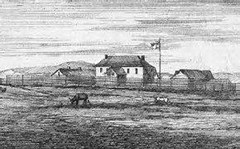A number of fur trading forts in the North West Territories still operated after the Hudson’s Bay Company had surrendered Rupert’s Land to the Canadian government in 1870. Fort Ellice was a Hudson Bay Post dating back to 1831 situated on the banks of the Assiniboine River, near present day St. Lazare, Manitoba. It was an important depot and distribution centre during the fur trading days, as well as in the 1870s during the settlement of that part of Manitoba. It was also impressive in appearance, situated in the valley with a magnificent view. For decades, it had been a bustling place with the long trains of freighter wagons making their way in various directions. A number of trails crossed and crisscrossed the prairies and park belt. The most important of these was the Carleton Trail, beginning at Fort Garry , west to Fort Ellice with a branch going to Fort Pelly, one going southward to Moose Mountain and then west to Wood Mountain. The main trail went northwest to Batoche where a ferry carried travelers and goods across the South Saskatchewan River to Fort Carleton, then to Battleford, Fort Pitt and Edmonton. Another branch went south from Fort Ellice to Fort Qu’Appelle and on to the Cypress Hills. At time of settlement going westward from Manitoba in 1882, Fort Ellice became a major stopping place for suppliers to obtain hardware, utensils, implements, dry goods, canned goods, groceries, ammunition, fish hooks, meats and bibles. The first York Colonists of 1882 under the York Farmers Colonization Company made their way from Winnipeg to Fort Ellice, and taking the Carleton Trail for some distance, they had to break trail to the new site. It was not an easy beginning. Until the railways came, these forts were of vital importance to the new settlers. They were not only supply centers, but a place of rendez-vous for trading furs, a place to stay to heal illnesses or injuries, to rest and feed oxen or horses and to socialize. There was usually liquor to be found at these forts and that could be problematic. There are no records of Yorkton settlers being interested in partaking of spirits and experiencing too good a time at Fort Ellice, perhaps because a good many were teetotalers who later were the backbone of temperance movements in Yorkton. The fort was closed in 1888.
Contact Terri Lefebvre Prince,
Heritage Researcher,
City of Yorkton Archives,
Box 400, 37 Third Avenue North
Yorkton, Sask. S3N 2W3
306-786-1722
[email protected]




